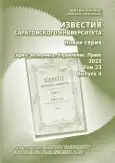Comparative statistical analysis of industrial development in post-Soviet countries for the period 1990–2021
- Authors: Petrovskaya M.V.1, Tsypin A.P.2, Sharykina E.A.3
-
Affiliations:
- Peoples’ Friendship University of Russia named after Patrice Lumumba
- Financial University under the Government of the Russian Federation
- Russian Biotechnological University (ROSBIOTECH)
- Issue: Vol 23, No 4 (2023)
- Pages: 411-419
- Section: Articles
- URL: https://journals.rcsi.science/1994-2540/article/view/251978
- DOI: https://doi.org/10.18500/1994-2540-2023-23-4-411-419
- EDN: https://elibrary.ru/PQSMDZ
- ID: 251978
Cite item
Full Text
Abstract
About the authors
Maria Vladimirovna Petrovskaya
Peoples’ Friendship University of Russia named after Patrice Lumumba
ORCID iD: 0000-0002-0668-9019
6 Miklukho-Maclaya St., Moscow 117198, Russia
Alexander Pavlovich Tsypin
Financial University under the Government of the Russian Federation125993, Moscow, Leningradsky avenue, 49
Elsa Anatolyevna Sharykina
Russian Biotechnological University (ROSBIOTECH)
ORCID iD: 0000-0003-1082-7821
11 Volokolamskoye Shosse , Moscow 125080, Russia
References
- Вилкова М. А. Роль крупнейших ТНК добывающей отрасли в развитии инвестиционного сотрудничества между странами ЕАЭС // Экономика и бизнес: теория и практика. 2021. № 6–1 (76). С. 19–22. https://doi.org/10.24412/2411-0450-2021-6-1-19-22
- Павловская Ю. В. Развитие кооперации организаций обрабатывающей промышленности в ЕАЭС // Экономический бюллетень Научно-исследовательского экономического института Министерства экономики Республики Беларусь. 2019. № 7 (265). С. 23–36. EDN: WNQMXI
- Плакиткина Л. С. Современное состояние и тенденции развития добычи угля в странах СНГ // Горная промышленность. 2013. № 2 (108). С. 18. EDN: QYOKUP
- Родионова И. А., Кокуйцева Т. В. Страны СНГ в международных рейтингах по уровню развития промышленности // Инновационная экономика. 2018. № 2 (15). С. 10. EDN: ORPSUP
- Саякбаева А. А., Макеева С. Б. Проблемы развития пищевой промышленности в контексте продовольственной безопасности Кыргызской Республики в условиях ЕАЭС и мировой практики // Актуальные вопросы современной экономики. 2020. № 5. С. 517–524. https://doi.org/10.34755/IROK.2020.94.17.191
- Стратонова Н. В. Пути развития национальной стандартизации объектов молочной промышленности в условиях ЕАЭС // Актуальные вопросы молочной промышленности, межотраслевые технологии и системы управления качеством : сб. науч. тр. / под ред. А. Г. Галстяна. М. : ВНИМИ, 2020. Вып. 1. С. 519–525. https://doi.org/10.37442/978-5-6043854-1-8-2020-1-519-525
- Часовский В. И. Влияние центро-периферийного развития на изменение территориальной структуры промышленности стран СНГ // Известия Смоленского государственного университета. 2008. № 2. С. 11–19.
- Эралиева А. А. Технологическая модернизация промышленных предприятий в цифровой экономике в странах ЕАЭС // Научный результат. Экономические исследования. 2021. Т. 7, № 3. С. 41–50. https://doi.org/10.18413/2409-1634-2021-7-3-0-3
- Ямпольская Д. О., Алиева К. А. Развитие рынка ЕАЭС на примере продукции электронной промышленности // Российский внешнеэкономический вестник. 2020. № 12. С. 33–52. https://doi.org/10.24411/2072-8042-2020-10120
- Цыпин А. П., Тимофеев Д. Н. Изучение развития промышленности России в 1930–2011 годах с использованием статистических методов // Экономическое возрождение России. 2014. № 1 (39). С. 54–59.
- Цыпин А. П. Ретроспективный анализ развития промышленного производства республик СССР за 1950–1990 гг. // Интеллект. Инновации. Инвестиции. 2018. № 5. С. 31–35. EDN: XVILGX
- National Accounts. URL: https://unstats.un.org/unsd/snaama/Downloads (дата обращения: 14.05.2023).
- World Bank Open Data // World Bank. URL: https://data.worldbank.org/ (дата обращения: 14.05.2023).
- Statistical Review of World Energy. URL: https://www.bp.com/content/dam/bp/business-sites/en/global/corporate/pdfs/energy-economics/statistical-review/bp-stats-review-2022-full-report.pdf (дата обращения: 14.05.2023).
- Steel Statistical Yearbooks // The World Steel Association (worldsteel). URL: https://worldsteel.org/steel-topics/statistics/steel-statistical-yearbook/ (дата обращения: 14.05.2023).
- Forestry Production and Trade. URL: https://www.fao.org/faostat/en/#data/FO (дата обращения: 14.05.2023).
- International Trade Statistics Yearbook. URL: https://comtradeplus.un.org/Publication/ITSY (дата обращения: 14.05.2023).
Supplementary files









